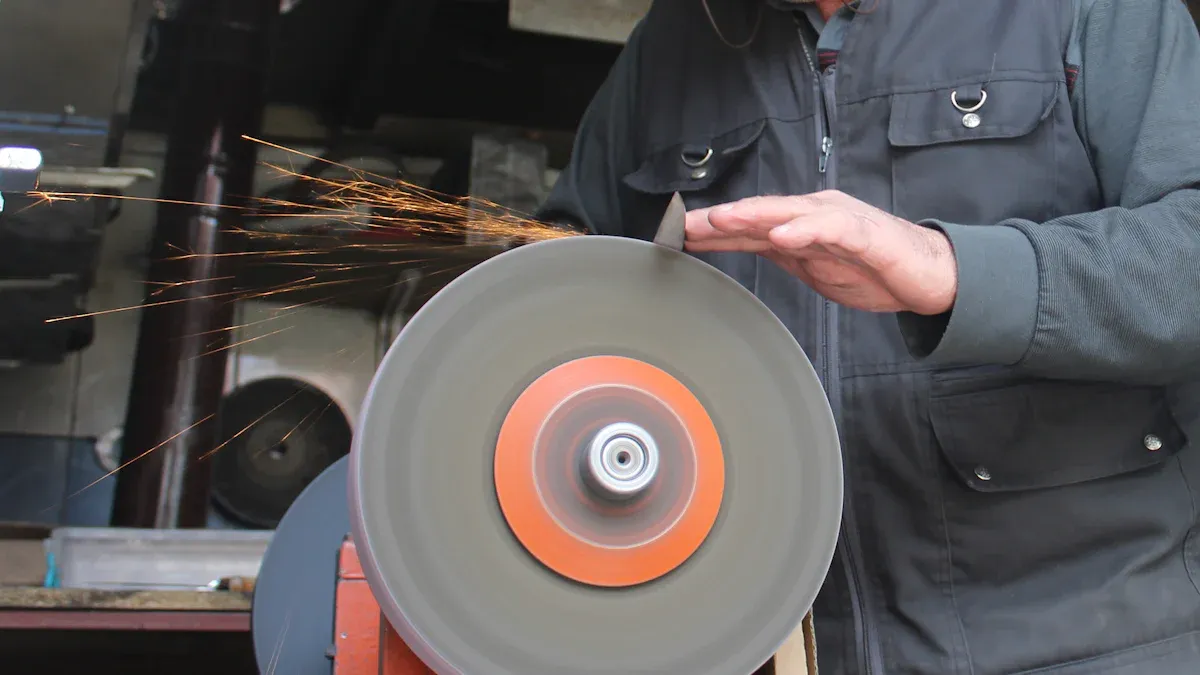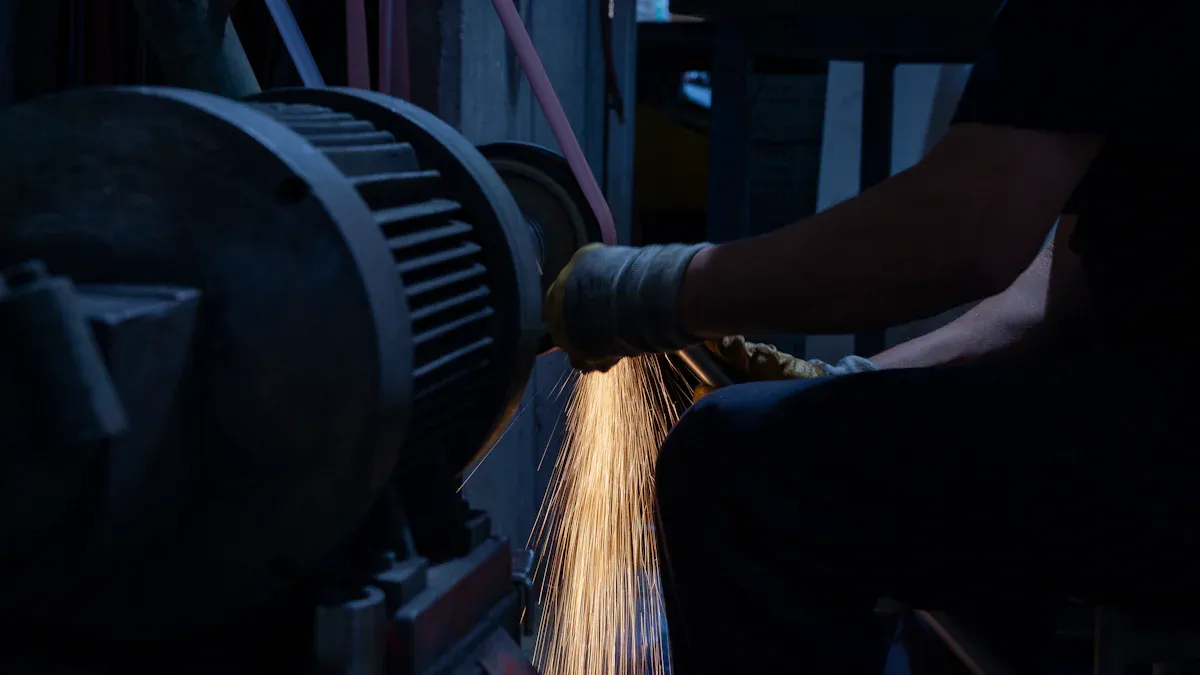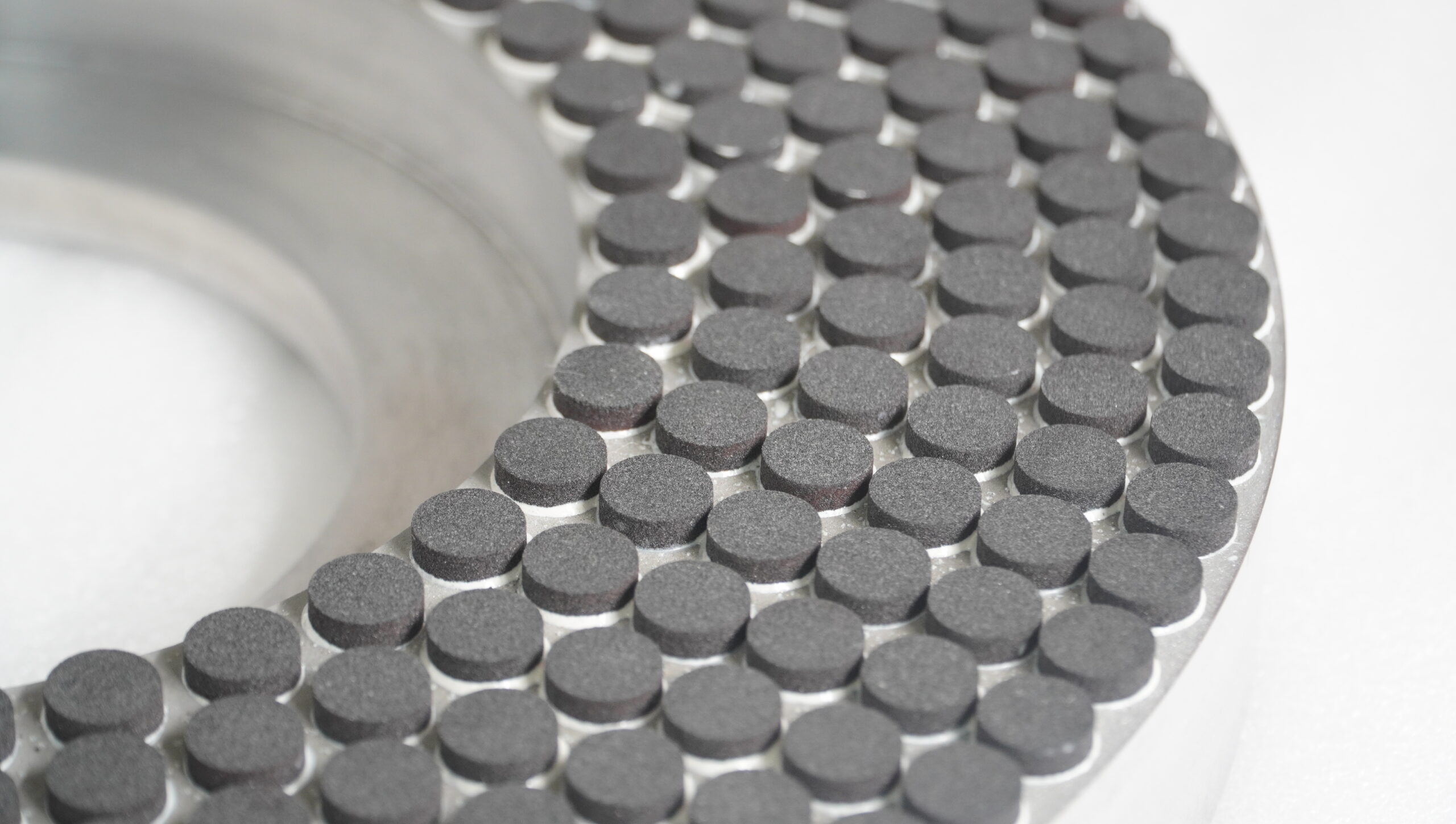A CBN grinding wheel uses cubic boron nitride, a superabrasive material, to shape and finish hard metals. Cubic boron nitride stands out because it is the second hardest material after diamond. The table below shows how its hardness compares to other common abrasives:
|
Material |
Knoop Hardness (GPa) |
|---|---|
|
Diamond |
~50 |
|
Cubic Boron Nitride |
|
|
Aluminum Oxide |
16 – 17 |
This unique hardness allows a CBN grinding wheel to cut tough metals quickly and last longer than conventional wheels.
Key Takeaways
-
CBN grinding wheels use cubic boron nitride, a very hard material, to grind tough metals quickly and last much longer than regular wheels.
-
These wheels cut hard steels precisely while resisting heat, which helps prevent damage to both the tool and the workpiece.
-
CBN wheels reduce downtime and maintenance costs by keeping their sharpness longer and needing fewer replacements.
-
Choosing the right bond type and grain size improves grinding quality and wheel life for different jobs and materials.
-
CBN grinding wheels are ideal for industries like automotive, aerospace, and tool making, where precision and durability matter most.
CBN Grinding Wheel Basics

Material & Structure
A CBN grinding wheel contains cubic boron nitride as its main abrasive. Cubic boron nitride, with the chemical formula BN, consists of boron and nitrogen atoms arranged in a cubic crystal structure. This structure closely resembles the diamond lattice, where boron and nitrogen atoms alternate in a diamond-like pattern. The cubic form gives cBN its remarkable hardness and thermal stability. Manufacturers create cBN by exposing boron and nitrogen to high pressure and high temperature, which forms the strong cubic bonds.
The abrasive grains are held together by a bonding material. Engineers design these bonds to lock the cBN particles in place, preventing them from falling out during grinding. Several types of bonds exist, such as vitrified, resin, metal, and hybrid bonds. Vitrified bonds use glass or ceramic materials, which provide strength and allow coolant to flow through the wheel. Resin bonds use high-performance resins like phenolic or polyimide, which help the wheel keep its sharpness and reduce heat. The choice of bond affects the wheel’s hardness, durability, and ability to handle heat.
Note: The bond system in a CBN grinding wheel plays a key role in supporting high-speed and high-performance grinding. It keeps the abrasive grains sharp and helps the wheel last longer.
The grain size of the cBN abrasive also matters. Coarse grains remove material quickly and work well for rough grinding, but they leave a rougher surface. Fine grains produce a smoother finish and are better for precision work. Manufacturers often choose grain sizes 1-2 grades finer than those used in ordinary abrasive wheels to achieve the same surface quality.
Key Properties
Cubic boron nitride gives the CBN grinding wheel several important properties. Its hardness is second only to diamond, making it ideal for cutting and shaping hard metals. The cubic structure also provides high thermal stability. Unlike diamond, cBN does not break down at high temperatures and can withstand heat up to about 1400°C. This makes it suitable for grinding hardened steels and alloys.
CBN wheels also have high thermal conductivity. They remove most of the heat from the grinding zone, which protects the workpiece from burns and damage. The chemical structure of cBN makes it inert to ferrous metals, so it does not react with steel during grinding. This property allows the wheel to keep its shape and sharpness even after long use.
The mechanical strength of a CBN grinding wheel depends on the grain size and the type of bond. A denser microstructure, achieved by using the right binder, increases fracture toughness and abrasion resistance. The table below summarizes some key mechanical properties:
|
Property |
Description / Range |
|---|---|
|
Hardness |
Very high; decreases with larger grain size and more binder |
|
Fracture Toughness |
High; depends on grain size and binder content |
|
Fracture Strength |
|
|
Grain Size |
2–20 µm (before sintering), 1.5–14 µm (after sintering) |
The latest advancements in CBN grinding wheel technology include engineered grains with better thermal conductivity and wear resistance, as well as hybrid bonding systems that combine the strengths of different materials. These improvements help the wheels last longer, cut faster, and produce better surface finishes.
How It Works

Abrasive Action
A CBN grinding wheel removes material from hard metals through a mix of cutting and fracturing. When the wheel spins, sharp cubic boron nitride grains contact the metal surface. These grains act like tiny cutting tools. They slice into the metal, shaving off small chips with each pass. The process starts when silicon carbide particles hit the wheel’s surface. This impact wears away the metal bond that holds the cBN grains. As the bond erodes, it exposes fresh, sharp edges of the cBN grains.
The exposed grains then cut into the metal. Over time, stress builds up in the grains. Some grains break along weak spots, which creates new sharp edges. This cycle of cutting and breaking keeps the wheel sharp and effective. The grinding wheel’s porous structure helps store metal chips and lets heat escape. Engineers can change the size of the abrasive grains and the way they are exposed to control how fast the wheel removes material and how smooth the finished surface looks.
-
CBN grinding wheels can work up to 100 times faster than regular abrasive wheels when shaping parts like camshafts.
-
They allow for very fine adjustments, as small as 1 micrometer, which helps reduce waste and lower costs.
-
Their high hardness and wear resistance mean they last longer and keep working well over time.
-
These wheels also help keep the workpiece size more uniform and create less pollution.
Grinding efficiency depends on how much energy the wheel uses to remove material. CBN grinding wheels usually need less energy than regular wheels. This means they cut faster and use less power.
Tip: The right abrasive blasting settings, such as particle size and blasting time, can improve grinding efficiency and surface finish.
Heat Resistance
Grinding hard metals creates a lot of heat. If the wheel cannot handle this heat, the workpiece can get damaged or burned. CBN grinding wheels have high thermal conductivity, which means they move heat away from the grinding area quickly. This keeps the grinding temperature lower than with regular wheels.
Some advanced wheels use special designs, like oscillating heat pipes inside the wheel. These pipes help move heat out of the grinding zone even faster. By removing heat quickly, the wheel protects the workpiece from thermal damage, such as burning or warping. This is especially important when grinding tough materials like Inconel 718, a superalloy used in jet engines.
-
High thermal conductivity and hardness lower the grinding force and temperature.
-
Special heat pipes inside some wheels boost heat transfer and keep the grinding zone cool.
-
Better heat dissipation prevents heat buildup, which reduces the risk of burning the workpiece.
-
With improved cooling, the cBN grains wear down more slowly, so the wheel lasts longer and keeps grinding quality high.
-
These features also mean less need for cooling fluids, making the process safer for the environment.
Note: Good heat resistance in a CBN grinding wheel helps avoid costly mistakes and keeps both the tool and the workpiece in better shape.
CBN Grinding Wheel vs Other Wheels
Diamond Wheels
Diamond wheels use synthetic diamond crystals as their abrasive material. Diamond is the hardest known substance. These wheels cut very hard, non-ferrous materials like ceramics, glass, and carbides. Diamond wheels work best for materials that do not contain iron. When grinding iron or steel, diamond reacts with the metal at high temperatures. This reaction causes the diamond to break down quickly, making it less effective.
CBN grinding wheels use cubic boron nitride, which is almost as hard as diamond. However, CBN does not react with iron. This makes it the better choice for grinding steel and other ferrous metals. CBN wheels keep their cutting ability at temperatures up to 1000°C. Diamond wheels lose their sharpness when used on iron-based materials.
|
Aspect |
Diamond Grinding Wheels |
CBN Grinding Wheels |
|---|---|---|
|
Abrasive Material |
Synthetic diamond |
Cubic boron nitride |
|
Best For |
Non-ferrous (ceramics, glass, carbides) |
Ferrous (hardened steels, cast iron) |
|
Chemical Stability |
Reacts with iron at high heat |
Stable with iron, no reaction |
|
Thermal Stability |
High, but degrades on ferrous metals |
Excellent, keeps cutting at high temps |
|
Typical Applications |
Carbide tools, glass, ceramics |
Automotive, aerospace, tool grinding |
Tip: Use diamond wheels for non-ferrous materials and CBN wheels for ferrous metals to get the best results.
Conventional Wheels
Conventional grinding wheels use abrasives like aluminum oxide or silicon carbide. These materials are softer than both diamond and CBN. Conventional wheels cost less at first, but they wear out much faster. They need to be replaced more often, which can slow down production.
CBN grinding wheels last much longer and keep their shape better. They grind hard steels and superalloys with high speed and precision. Conventional wheels may struggle with these tough materials. CBN wheels also work well at high temperatures, while conventional wheels can lose their hardness and damage the workpiece.
-
CBN wheels can cost up to 10 times more than conventional wheels.
-
They last 100–300 times longer, saving money over time.
-
Less downtime and fewer replacements help factories work more efficiently.
|
Performance Aspect |
CBN Grinding Wheels |
Conventional Wheels |
|---|---|---|
|
Hardness and Wear Resistance |
Very high, lasts longer |
Lower, wears out faster |
|
Grinding Efficiency |
High, fast material removal |
Lower, slower grinding |
|
Service Life |
Long, less frequent replacement |
Short, needs frequent replacement |
|
Cost |
Higher upfront, lower long-term |
Lower upfront, higher long-term |
|
Best Use |
Hardened steels, superalloys, precision grinding |
Softer metals, general grinding |
Note: While conventional wheels are cheaper, CBN grinding wheels offer better value for tough jobs and heavy use.
Advantages & Uses
Main Benefits
A CBN grinding wheel offers several important benefits for industrial grinding tasks. Its high hardness and wear resistance allow it to outperform traditional grinding wheels. Users notice that these wheels keep their cutting edge much longer, which means fewer replacements and less downtime. The strong wear resistance also reduces the need for frequent dressing, so maintenance intervals become longer.
-
Maintains grinding performance for a longer time
-
Reduces the frequency of dressing and replacement
-
Lowers overall tooling costs by lasting longer
-
Improves processing quality by reducing surface damage and deformation
-
Provides excellent heat resistance, preventing thermal damage to both the wheel and the workpiece
Note: Although the initial cost of a CBN grinding wheel is higher, the savings from reduced maintenance and longer tool life make it a cost-effective choice over time.
CBN wheels also help achieve better surface finishes, especially on hardened steel. Fine-grit wheels balance fast material removal with smooth finishes. Using the right grinding parameters and coolants further improves the surface quality and extends wheel life.
Typical Applications
Industries use CBN grinding wheels in many demanding applications. These wheels work best for grinding hard ferrous metals, such as hardened steels and high-speed steel tools. Their superior hardness and thermal stability make them ideal for precision work.
|
Industry |
Materials Processed |
|
|---|---|---|
|
Automotive |
Grinding of gears, camshafts, valve seats |
Hardened steels |
|
Aerospace |
Grinding turbine blades, landing gear parts |
Hard alloys, superalloys |
|
Tool and Die |
Regrinding HSS cutting tools, end mill sharpening |
High-speed steel (HSS), ferrous metals |
|
Gear Manufacturing |
Profile grinding of helical, bevel gears |
Hardened steels |
|
Bearing Industry |
Grinding races, rollers, balls |
Hardened steels |
CBN grinding wheels also see use in the medical field for shaping surgical tools. Their ability to grind hard materials with minimal heat damage makes them valuable in any setting where precision and durability matter.
Types & Selection
CBN Grinding Wheel Types
Manufacturers offer several types of CBN wheels, each with unique features and uses. The three most common types are resin bond, vitrified bond, and electroplated bond wheels. The table below compares their main characteristics:
|
Type of CBN Wheel |
Features |
Typical Use Cases |
Key Advantages |
|---|---|---|---|
|
Resin Bond |
Uses thermosetting resin; easy to dress; releases grains before dulling; sensitive to heat |
Tool and cutter grinding, surface grinding, HSS sharpening |
Fine finish, flexible, cost-effective |
|
Vitrified Bond |
Glassy, porous structure; high temperature resistance; longest life |
Precision grinding in automotive, aerospace, bearings |
Superior accuracy, excellent wear resistance |
|
Electroplated Bond |
Single layer of CBN grains; aggressive cutting; highest grain exposure |
Plunge grinding, form grinding, hard-to-grind materials |
Aggressive, maintains shape, reusable core |
Resin bond wheels work well for tool and cutter grinding. They provide a smooth finish and adapt to different shapes. Vitrified bond wheels suit high-precision jobs. Their porous structure allows coolant to flow, keeping the wheel cool during fast grinding. Electroplated wheels cut aggressively and keep their form, making them ideal for complex shapes and hard materials.
Tip: Vitrified bond wheels last the longest and handle high speeds, while resin bond wheels are easier to dress and use for fine finishing.
Choosing the Right Wheel
Selecting the best wheel depends on several factors. Consider these points:
-
Material Compatibility: Choose CBN wheels for hardened steels, cast irons, and nickel alloys. These wheels resist heat and chemical reactions with ferrous metals.
-
Bond Type: Use resin bonds for shock absorption and rough grinding. Pick vitrified bonds for aggressive, high-precision work. Electroplated bonds fit complex shapes and aggressive grinding.
-
Grinding Conditions: Wet grinding with oil-based coolant improves cooling and wheel life. Dry grinding works with resin bonds at low speeds and feeds. High speeds and feeds need vitrified or electroplated wheels with strong bonds.
-
Wheel Size and Grit: Match the wheel size to the machine and job. Coarse grits remove material quickly but leave rougher surfaces. Fine grits give smoother finishes.
-
Maintenance and Cost: Vitrified wheels cost more but last longer. Resin and electroplated wheels are less expensive but may need more frequent replacement or dressing.
-
Always check the grinding speed and feed rate. High speeds require wheels with strong bonds and proper coolant.
-
Watch for signs of wheel glazing or loading. Softer bonds or more frequent dressing may help.
-
Proper mounting, truing, and dressing keep the wheel working well.
Note: The right combination of bond type, grit size, and coolant leads to better grinding results and longer wheel life.
-
CBN grinding wheels offer exceptional hardness and durability, lasting much longer than traditional wheels.
-
They provide efficient, precise grinding with sharp cutting edges, especially on hardened steels.
-
High thermal conductivity helps prevent heat damage and supports faster grinding.
-
These wheels reduce overall costs by minimizing downtime and maintenance.
-
Their versatility makes them valuable in many industries.
Users should always match the wheel to the material and review grit size and bond type for the best results.
FAQ
What materials can a CBN grinding wheel grind?
A CBN grinding wheel works best on hard ferrous metals. These include hardened steel, cast iron, and nickel-based alloys. It does not perform well on soft metals or non-ferrous materials like aluminum or copper.
How long does a CBN grinding wheel last?
CBN grinding wheels last much longer than conventional wheels. Many users report that a CBN wheel can outlast a standard wheel by 100 to 300 times, depending on the application and material.
Can you use a CBN wheel dry, or does it need coolant?
Most CBN wheels work best with coolant. Coolant helps control heat and extends wheel life. Some resin bond wheels allow dry grinding at low speeds, but using coolant is safer for both the wheel and the workpiece.
How do you dress a CBN grinding wheel?
Operators use a diamond dressing stick or a special dressing tool. Dressing removes debris and exposes fresh abrasive grains. This process keeps the wheel sharp and maintains its shape.
Are CBN grinding wheels safe for all grinding machines?
Not every grinding machine supports CBN wheels. Machines must reach the correct speed and have proper mounting systems. Always check the manufacturer’s guidelines before using a CBN wheel.
Contact Us
For More Grinding Solution or Customized Abrasive Tools

